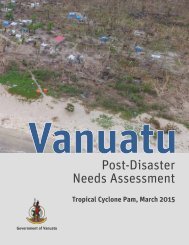Fiji
yqgk302EGjo
yqgk302EGjo
You also want an ePaper? Increase the reach of your titles
YUMPU automatically turns print PDFs into web optimized ePapers that Google loves.
FIJI Post-Disaster Needs Assessment<br />
The recovery needs that were identified during the PDNA process are not linked to the availability or form of recovery<br />
funding, but are driven by the sectoral needs analyses. Given the extent of identified needs and the limited resources, the<br />
first step would be to prioritize the sectors for recovery and reconstruction based on the available financial envelope and<br />
a number of strategic considerations. A criteria-based prioritization of recovery needs across competing sectors will be<br />
necessary, the principles of which could include:<br />
<br />
<br />
<br />
<br />
<br />
<br />
<br />
<br />
<br />
<br />
The recovery programme, while implemented under the government’s leadership, will be carried out in close and<br />
collaborative partnership with international donors, the private sector, civil society and the community as a whole.<br />
6.1 Development of a Disaster Recovery<br />
Framework<br />
The PDNA and similar disaster assessments are an essential component of a successful DRF, which will include: (i)<br />
developing a central vision for recovery; (ii) defining guiding principles; (iii) identifying primary recovery sectors; (iv) assessing<br />
government capacity to manage recovery; (v) appointing an appropriate recovery leader; (vi) establishing appropriate<br />
institutional arrangements; (vii) clarifying institutional roles and responsibilities; and (viii) establishing coordination<br />
mechanisms, conducting funding gap analysis and mobilizing funds.<br />
The DRF will cover immediate and short-term needs identified in this PDNA for the first two years of recovery (2016-2018).<br />
The National Development Plan will cover recovery and reconstruction needs and priorities from two years onwards in the<br />
medium term (2018-2020) and long term (2020 onwards).<br />
Following the first annual results review for the respective flagship programmes conducted by the Ministry of Finance,<br />
in conjunction with line ministries, the required long-term strategies, including policy options, can be reassessed. The<br />
results can then be incorporated into the National Development Plan to guide the programmatic approach, planning,<br />
implementation and monitoring of the medium- and long-term recovery and rehabilitation programmes and projects.<br />
6.2 Institutional and Policy Setup<br />
(including Goods and Services)<br />
Policy and institutional gaps to implementation can cause headaches for agencies involved in recovery in affected<br />
communities. These gaps will need to be identified immediately by the government and addressed to support an efficient<br />
and effective recovery. Currently, there is the need to:<br />
<br />
<br />
<br />
<br />
<br />
<br />
<br />
partners, communities and civil society organizations;<br />
<br />
recovery projects;<br />
<br />
<br />
requires a mix of skills (in particular for procurement, financial management and safeguard requirements) that should<br />
be made available to support the programme’s processes and procedures.<br />
Tropical Cyclone Winston, February 20, 2016<br />
123



